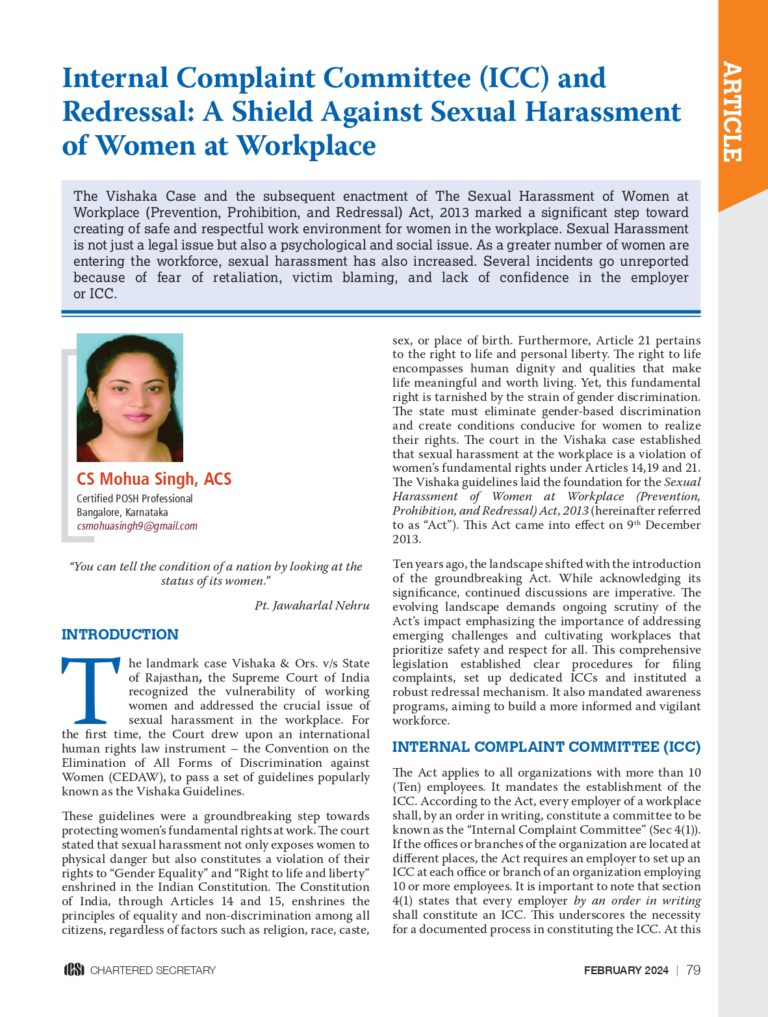The Sexual Harassment of Women at Workplace (Prevention, Prohibition and Redressal) (POSH) Act, 2013.
POSH (Part – 7)
Virtual Sexual Harassment
Introduction
During the COVID-19 pandemic, lockdowns forced workplaces to shift to remote work, making work-from-home the new normal. As the workplaces shifted from traditional workplaces to online platforms, it was anticipated that sexual harassment cases would decrease. However, concern grew as reports documented a concerning surge in such cases. Rather than reducing, incidents of sexual harassment adapted to the virtual landscape, with predators exploiting online platforms such as Zoom, Skype, and messaging apps to continue their abusive behavior. Women working from home have reported being targeted by their harassers through Zoom, Microsoft Teams, social media, messages, and phone calls. This alarming trend underscores the urgent need for robust measures to tackle sexual harassment in both physical and virtual work environments.
What is Virtual Sexual Harassment?
Virtual sexual harassment refers to any form of online unwanted verbal or non-verbal conduct of a sexual nature with the purpose or effect of violating the dignity of a person, in particular by creating an intimidating, hostile, degrading, humiliating, or offensive environment.
Virtual harassment can take many forms including:
Textual Sexual Harassment involves the use of written communication, such as emails, text messages, or instant messages, to engage in sexually inappropriate behavior or comments.
Sextortion refers to the use of digital platforms to blackmail a victim. In such cases, the perpetrator threatens to release intimate pictures of the victim to extort additional explicit photos, videos, sexual acts, or sex from the victim.
Cyberstalking refers to the use of online platforms to harass, intimidate, or monitor an individual, causing fear and distress through digital means.
Doxing refers to the publication of private information such as contact details in the public domain with the malicious intent of damaging the creditability or reputation of someone.
Revenge Prone is an unauthorized online sharing of intimate images, whether obtained with or without the consent of the victim, aiming to shame, stigmatize, or inflict harm on the victim.
All the abovementioned forms of online violence create a permanent digital record that can be distributed worldwide and cannot be easily deleted, which may result in further victimization of the victim.
Does remote working or working from home fall under the definition “Workplace” provided in the Act?
As per the definition provided in Section 2(o) of the Act, ‘Workplace’ includes any government or private sector organization, department, branch, or unit from which it carries out its commercial activities. ‘Workplace’ also includes any place visited by the employee arising out of or during employment, including transportation provided by the employer. Now, the question arises whether remote working or working from home comes under the definition of workplace. The section of the Act does not explicitly cover online or digital workplaces.
However, from time to time, the Indian judiciary has made it clear that the definition of Workplace is inclusive and can be extended to capture the intent of the legislature.
In Jaya Kodate v. Rashtrasant Tukdoji Maharaj Nagpur University, the Bombay High Court stated that the definition of ‘workplace’ under the 2013 Act is inclusive and deliberately kept wide by the Parliament to ensure that any area where women may be vulnerable to sexual harassment is not left unattended for.
In Saurabh Kumar Mallick v. Comptroller & Auditor General of India, the honorable Delhi High Court stated that “It is imperative to take into consideration the recent trend which has emerged with the advent of computer and internet technology and the advancement of information technology. A person can interact or have a business conference with another person while sitting in another country through video conferencing. It has also become a trend that the office is being run by CEOs from their residence. In a case like this, if such an officer indulges in an act of sexual harassment with an employee, say, his private secretary, it would not be open for him to say that he had not committed the act at ‘workplace’ but at his ‘residence’ and get away with the same.”
In Sanjeev Mishra vs. Bank of Baroda, the Rajasthan High Court extended the definition of “workplace harassment” to encompass online abuse.
Thus, on several occasions, the Indian courts have extended the definition of workplaces to protect working women. The above judgments make it clear that ‘remote workplace’ or ‘working from home’ comes under the definition of workplace.
How to prevent Virtual Sexual Harassment?
- Evaluate the existing policies: The emphasis on improving Organisational culture should not be lost just because your employees are working remotely. Organizations must periodically evaluate and revise their existing Prevention of Sexual Harassment policies, considering the shift in work dynamics and the expanding use of digital tools. Drafting a work-from-home/Remote Working Code of Conduct is essential to establish clear guidelines reminiscent of a formal office environment. This document should delineate dos and don’ts for employees, covering aspects like social media conduct, decorum, screen sharing etiquette, optimal timing for virtual meetings and calls, language usage, appropriate attire, webcam protocols, and defining work shifts.
- Focus on cultural improvement and communicate expectations: An Organization should focus on cultural improvement that reduces the likelihood of offensive incidents. Ensure that your employees understand what conduct constitutes sexual harassment and what is appropriate behavior in work-related communication. Organizations should regularly conduct targeted training to improve their work culture and set expectations on understanding appropriate behavior during video calls.
- Empowering Reporting Channels: Providing clear avenues for employees to report incidents of sexual harassment is essential. Employees should feel empowered to speak up without fear of reprisal.
- Swift and Supportive Response: When complaints arise, addressing them promptly and empathetically, without biases is important. This attitude will not only support the victim but also foster a safe work environment.
- What are the Legal Provisions under various Laws?
- The Indian Penal Code, 1960
Section 354A – This section was introduced in the Indian Penal Code by way of the Criminal Law (Amendment) Act, 2013 to protect the dignity of individuals. This section describes what constitutes sexual harassment and it is noteworthy that it has been made irrelevant whether any criminal force or assault was used or not. Section 354A provides provisions for offenses such as physical contact and advances, demand for favors, or making sexually colored remarks. The section also covers offenses such as showing pornography against the will of a woman and any unwelcome physical, verbal, or non-verbal conduct of a sexual nature.
Under Section 354A, the penalties for offenses include imprisonment of up to three years, a fine, or both. The severity of the punishment may vary based on the nature of the offenses, the impact on the victim, and the circumstances surrounding the incident.
Section 354C – This section addresses the offense of voyeurism. With the widespread use of technology, especially smartphones and hidden cameras instances of voyeurism have been on the rise. It is crucial to respect an individual’s privacy and personal space.
Voyeurism – Any man who watches, captures the image of a woman engaging in a private act in circumstances where she would usually expect not to be observed either by the perpetrator or by any other person at the behest of the perpetrator, or disseminates such imageshall be punished on first conviction with imprisonment for a term which shall not be less than one year, but which may extend to three years, and shall also be liable to fine, and be punished on a second or subsequent conviction, with imprisonment for a term which shall not be less than three years, but which may extend to seven years, and shall also be liable to fine.
It is essential to understand that consent plays a vital role in determining whether an act amounts to voyeurism or not. Without consent, capturing visual images of a person in a private act is considered voyeurism under the law. Furthermore, if the victim consents to the capture of the images, but not to their dissemination, such an act shall be considered an offense under this section.
Section 354D – This section deals with the offense of stalking. Any man who follows a woman and contacts or attempts to contact such woman to foster personal interaction repeatedly despite a clear indication of disinterest by such woman or monitors the use by a woman of the internet, email, or any other form of electronic communication, commits the offense of stalking. This behavior causes the target person to feel harassed or to fear violence. If a person is found guilty of stalking under section 354D of the Indian Penal Code, the penalties include imprisonment for up to 3 years for the first offense and up to 5 years for subsequent offenses. Additionally, the person may be liable to pay a fine.
Section 499 – This provision pertains to situations where someone’s reputation is harmed by content posted on the internet, particularly focusing on remarks made on social media or the sharing of inappropriate images or videos meant for public view. In the case of women, online defamation can have severe consequences, impacting their personal and professional lives, as well as causing emotional distress. If found guilty under this provision, individuals who defame a woman online may be subject to a two-year imprisonment.
Section 503 – Threatening a woman with harm to her reputation, either to instill fear or coerce her actions, is considered criminal intimidation. This legal provision encompasses instances of online blackmail targeting women.
Section 509 – This section primarily deals with the offense of “Word, gesture, or act intended to insult the modesty of a woman.”
Whoever, intending to insult the modesty of any woman, utters any words, makes any sound or gesture, or exhibits any object, intending that such word or sound shall be heard, or that such gesture or object shall be seen, by such woman, or intrudes upon the privacy of such woman, shall be punished with simple imprisonment for a term which may extend to three years, and also with fine.
2. The Information Technology Act
Section 66E – This section deals with punishment for violation of privacy. Whoever, intentionally or knowingly captures, publishes, or transmits the image of a private area of any person without his or her consent, under circumstances violating the privacy of that person, shall be punished with imprisonment which may extend to three years or with fine not exceeding two lakh rupees, or with both.
For instance, an employee at a workplace who covertly records a colleague changing clothes in the Company locker room without her knowledge or consent would violate section 66E of the Information Technology Act.
Section 67 – This section deals with the punishment for publishing or transmitting obscene material in electronic form. Whoever publishes or transmits or causes to be published or transmitted in the electronic form, any material which is lascivious or appeals to the prurient interest or if its effect is such as to tend to deprave and corrupt persons who are likely, having regard to all relevant circumstances, to read, see or hear the matter contained or embodied in it, shall be punished on first conviction with imprisonment of either description for a term which may extend to three years and with fine which may extend to five lakh rupees and in the event of second or subsequent conviction with imprisonment of either description for a term which may extend to five years and also with fine which may extend to ten lakh rupees.
In the case of Ranjit D. Udeshi v. State of Maharashtra (1964), the Supreme Court of India provided the meaning of obscene. It said: “If any book, pamphlet, paper, writing, drawing, painting, representation, figure, or any other object is lascivious or appeals to the prurient interest or, if taken as a whole, is such as to tend to deprave or corrupt person, who is likely to read, see, or hear the matter contained or embodied in it, then such object shall be deemed to be obscene”.
For example – Let’s consider a scenario involving an employee who shares obscene content such as adult videos or images through their work email to their colleagues, such an act would violate section 67 of the Information Technology Act.
Section 67A – Whoever publishes or transmits or causes to be published or transmitted in the electronic form any material which contains sexually explicit act or conduct shall be punished on first conviction with imprisonment of either description for a term which may extend to five years and with fine which may extend to ten lakh rupees and in the event of second or subsequent conviction with imprisonment of either description for a term which may extend to seven years and also with fine which may extend to ten lakh rupees.
For example, if an employee records intimate videos or takes compromising photos of colleagues or clients during work-related events or activities without their knowledge or consent, and then shares or distributes these materials online using company resources or platforms, it would be a breach of section 67A of the Information Technology Act.
Conclusion
In conclusion, addressing virtual sexual harassment requires collective efforts by organizations, governments, and society at large. Organizations must take the lead by adopting robust policies that clearly define virtual sexual harassment, prohibit virtual sexual harassment, and promote cultural changes. They should organize educational programs that cultivate a culture of respect and empower employees to speak up. The government should enact strong legislation that recognizes virtual sexual harassment as a serious offense. Finally, societal efforts are needed to dismantle the normalization of online misconduct. By fostering open conversations and a zero-tolerance policy for such behaviors, we can create a digital landscape where everyone feels valued and respected, regardless of gender and background.
…to be continued




